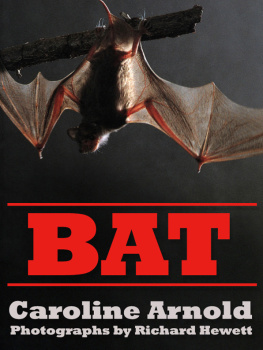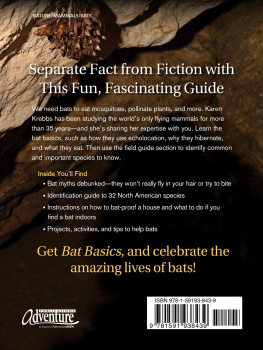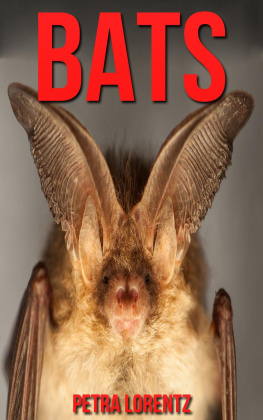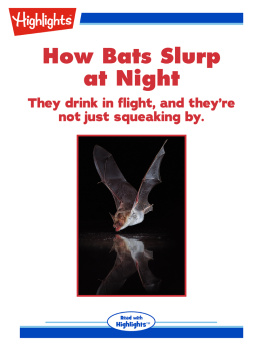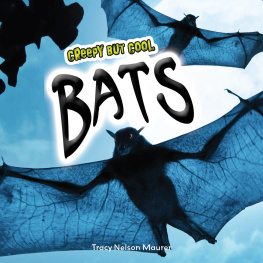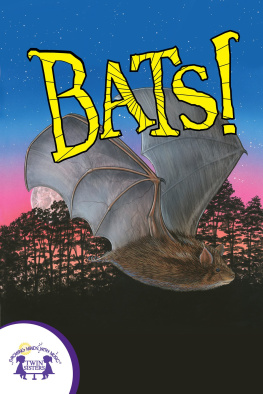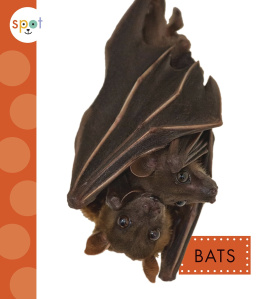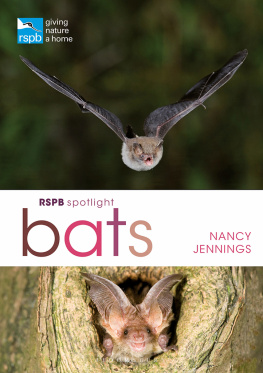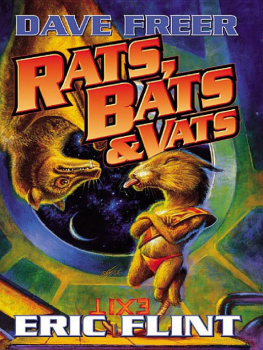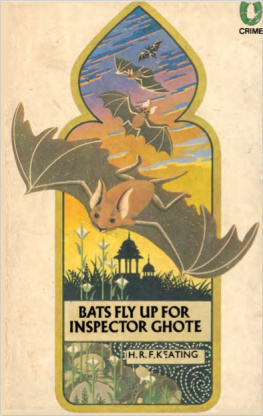Text and photographs copyright 2015 by Merlin Tuttle
All rights reserved
For information about permission to reproduce selections from this book, write to or to Permissions, Houghton Mifflin Harcourt Publishing Company, 3 Park Avenue, 19th Floor, New York, New York 10016.
www.hmhco.com
The Library of Congress has cataloged the print edition as follows:
Tuttle, Merlin D.
The secret lives of bats : my adventures with the world's most misunderstood mammals / Merlin Tuttle.
pages cm
Includes bibliographical references and index.
ISBN 978-0-544-38227-5 (hardcover)ISBN 978-0-544-39043-0 (ebook)
1. Bats. 2. BatsResearchAnecdotes. 3. Tuttle, Merlin D. I. Title.
QL737.C5T896 2015
569'.4074dc23
2015017314
Cover photograph Merlin Tuttle
Cover design by Martha Kennedy
v1.1015
I dedicate this book to the memory of Verne and Marion Read, who sponsored and participated in many of my early adventures in studying and conserving bats, and to my wife, Paula, who enthusiastically partners with me in all my continuing activities.
PREFACE
A City That Loves Bats
NEWSPAPER HEADLINES SCREAMED , Bat colonies sink teeth into city. They claimed that hundreds of thousands of rabid bats were invading and attacking the citizens of Austin, Texas. It was September 23, 1984, and 1.5 million Brazilian free-tailed bats had begun moving into 16-inch-deep crevices beneath the Congress Avenue Bridge, just a few blocks from the State Capitol.
For more than a decade, Americans had been bombarded with scary newspaper and magazine stories that often included vividly imaginative accounts of rabid bats attacking people. The Nightmare House, which appeared in the April 1, 1980, issue of Family Circle, even went so far as to claim that a family had been trapped in their home for three days and nights while a horde of bats attacked.
When Austin health officials added their warnings, many Austinites panicked and wanted the bats exterminated. Rather than viewing the great clouds of emerging bats as a wonder of nature, they were reminded of Alfred Hitchcocks terrifying classic, The Birds. Not surprisingly, people began imagining attacks from bats that were merely chasing flying insects, and Austin suddenly became the world center for scary bat stories.
Having just founded Bat Conservation International (BCI) to help people understand and appreciate bats, I felt that the new onslaught of frightening claims presented an extreme challenge. Nevertheless, I truly believed that Austin provided a golden opportunity to demonstrate that bats make wonderful neighbors. When I announced my resignation as curator of mammals at the Milwaukee Public Museum in Wisconsin so I could move BCI to Austin, nearly everyone thought Id lost my mind. On learning of my plans, Texas Monthly magazine gave me its Bum Steer award, a tongue-in-cheek distinction given for especially embarrassing decisions.
With only one employee, I moved BCI to Austin in March 1986. We were just in time for the bats spring return and within days, armed with several live ones, I began meeting with leading city officials, community leaders, and media representatives.
Fortunately, the truth about bats is extremely powerful. Free-tailed bats have strange faces, but their big brown eyes, winsome expressions, and gentle nature quickly converted countless skeptics. People frequently lost their fear in the blink of a bats eye. When prominent socialite Roberta Crenshaw was informed of my efforts, she declared, He might as well try saving cockroaches! She assured her friends that if she had to view one of my bats close up shed probably have nightmares for a month. Yet, when she finally gave in and took a look, she exclaimed, Oh myits cute! And she became one of Americas first supporters of BCI and an outspoken promoter of Austins bats.
Just two months after awarding me, Texas Monthly featured a story strongly supporting my bat conservation efforts. And just four years later, at a bridge-side ceremony attended by nearly 700 people, Mayor Lee Cooke proudly announced, Weve become the bat capital of America. Its really exciting that weve come from concern to a position where we want to protect, covet, and welcome the bats.
Even Governor Ann Richards became a bat fan. Soon after her election in 1991, she invited me to bring my bats to dinner to entertain her friends at the governors mansion. It was an evening frequently punctuated by exclamations of WowI had no idea! Did I hear you right? Bats from just one cave can eat more than a hundred tons of insects in a single night? and You really can train them like dogs?
Time and again in my more than 50 years of studying bats, Ive seen similarly dramatic conversions, perhaps explaining why I was brave enough to tackle Austin. It is simply amazing how quickly attitudes improve when people finally understand bats as they really aresophisticated, beautiful, even cute, quite aside from their crucial roles as primary predators of insects, pollinators of flowers, and dispersers of seeds.
Austin now carefully protects its bats and has become the world center for stories documenting bats as safe neighbors and valued allies. In more than 30 years of sharing our city with the worlds largest urban bat colony, no one has been harmed. And, simply left alone, these bats consume 15 tons of insects nightly. They also bring 12 million tourist dollars to downtown Austin each summer. On a typical August evening, people from all over the world line the Congress Avenue Bridge, jockeying shoulder to shoulder for favored views of the great emergence columns, truly one of our planets premier wildlife spectacles. The bats pass within just a few feet of a flickering storm of flashing cameras, up to five columns at a time that can be seen for more than a mile as great black ribbons against sunset skies.
Of course, I cant share live bats close upor even Austins bridge batswith more than a privileged few. However, in the following pages, I will share highlights from a lifetime of thrilling adventure and scientific discovery, covering every continent where bats live. From moonshiner standoffs to close encounters with tigers, cobras, and poachersand bats as cute as any panda and as strange as any dinosaur, tiny bumblebee bats to giant flying foxes. Follow along, and I hope that through my adventures, you too will become passionate about bats.
Acknowledgments
COUNTLESS INDIVIDUALS have provided critical inspiration and guidance, beginning with my parents, Horace and June Tuttle, who instilled a love of nature and can-do attitude and enthusiastically supported my early interest in becoming a bat biologist. Ernest S. Booths talk to my fifth-grade class inspired me to become a mammalogist. Charles O. Handley Jr. provided early inspiration to study bats and later hired me to lead his Mammals of the Smithsonian Venezuelan Project. He also played an important role in getting me accepted into a top graduate program at the University of Kansas. Joseph C. Howell and Wayne H. Davis enthusiastically assisted me with my first published research. J. Knox Jones Jr. and Robert S. Hoffmann provided invaluable counsel as my major professors in graduate school, and my former wife, Diane Stevenson, taught me to write.
While I was employed as curator of mammals at the Milwaukee Public Museum, Verne and Marion Read and their family virtually adopted me, providing crucial encouragement and financial support, including Vernes participation as Bat Conservation Internationals (BCI) founding trustee. Many of BCIs greatest achievements would not have been possible without the Reads leadership contributions.
Gordon M. Sears, chairman of T. J. Ross and Associates, Inc., and Bill Walker, president and CEO of Bacardi Limited, provided invaluable leadership guidance during the founding of BCI and served for many years as trustees. Additional trustees who provided special assistance include Jeff Acopian, Mark Adkins, Gene Ames Jr., David Bamberger, Eugenio Clariond, Mike Cook, Sharon Forsyth, Bob Gerrie, Don Grantges, Elizabeth Jones, Joan Kelleher, Travis and Bettina Mathis, Scott McVay, John Mitchell, Peggy Phillips, Mark Ritter, Beth Robertson, Andy Sansom, Lee Schmitt, D. J. Sibley, Marshall and Patsy Steves, Dave Weaver, and Mark Weinberger.
Next page

